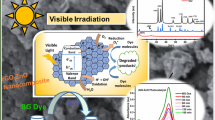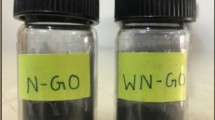Abstract
This research work focused on the synthesis of visible light-active ZnO photocatalyst through modification with nitrogen and graphene oxide, followed by its application towards the degradation of brilliant smart green (BG) dye. The characterization of the synthesized photocatalysts was done using optical approaches such as X-ray diffraction (XRD), Fourier transform infrared (FTIR), transmission electron microscopy (TEM), UV–vis absorption, and diffuse reflectance spectra (UV–vis DRS). N-ZnO-GO (NZGO-1, NZGO-2, and NZGO-3) composites show a higher photocatalytic activity in degrading BG dye in water compared to ZnO and N-ZnO nanoparticles. The composite NZGO-1 achieved 100% degradation and 80% mineralization of BG within 90 min of irradiation. The results also showed the degradation of BG using NZGO-1 occurs faster in basic medium (pH 9) compared to acidic medium. Photostability test of NZGO-1 analyzed after three cycles of exposure gave 94% degradation of BG which implies that the composite is also highly stable and can be recovered and reused. This study further highlighted that the modifications made on ZnO were positive by increasing its light absorption capability into the visible region and thus drastically improved its photocatalytic activities under visible light.








Similar content being viewed by others
References
Pathania D, Gupta D, Ala’a H, Sharma G, Kumar A, Naushad M, Ahamad T, Alshehri SM (2016) Photocatalytic degradation of highly toxic dyes using chitosan-g-poly (acrylamide)/ZnS in presence of solar irradiation. J Photochem Photobiol A Chem 329:61–68
http://science.howstuffworks.com/environmental/earth/geophysics/h2o1.htm. Accessed May 2017
Turabık M, Gozmen B (2013) Removal of basic textile dyes in single and multi-dye solutions by adsorption: statistical optimization and equilibrium isotherm studies. CLEAN–Soil, Air, Water 41:1080–1092
Gupta V (2009) Application of low-cost adsorbents for dye removal—a review. J Eviron Manage 90:2313–2342
Börnick H, Schmidt TC (2006) Amines. in Organic pollutants in the water cycle: properties, occurrence, analysis and environmental relevance of polar compounds. 181–209
Suteu D, Zaharia C, Bilba D, Muresan R, Popescu A, Muresan A (2009) Decolorization waste waters from the textile industry-physical methods, chemical methods. Ind Text 60:254–263
Yue Z, Mangun C, Economy J, Kemme P, Cropek D, Maloney S (2001) Removal of chemical contaminants from water to below USEPA MCL using fiber glass supported activated carbon filters. Environ Sci Technol 35:2844–2848
Mamba B, Krause R, Matsebula B, Haarhoff J (2009) Monitoring natural organic matter and disinfection by-products at different stages in two South African water treatment plants. Water SA 35:121–127
Kaushik P, Malik A (2009) Fungal dye decolourization: recent advances and future potential. Environ Int 35:127–141
Ohtani B (2010) Photocatalysis A to Z—what we know and what we do not know in a scientific sense. J Photochem Photobiol C: Photochem Rev 11:157–178
Zou Y, Gong Y, Lin B, Mellott NP (2016) Photodegradation of methylene blue in the visible spectrum: an efficient W6+ ion doped anatase titania photocatalyst via a solvothermal method. Vacuum 126:63–69
Tian C, Zhang Q, Wu A, Jiang M, Liang Z, Jiang B, Fu H (2012) Cost-effective large-scale synthesis of ZnO photocatalyst with excellent performance for dye photodegradation. Chem Commun 48:2858–2860
Anku WW Oppong SOB, Shukla SK, Govender PP (2016) Synthesis and characterisation of neodymium doped-zinc oxide–graphene oxide nanocomposite as a highly efficient photocatalyst for enhanced degradation of indigo carmine in water under simulated solar light. Res Chem Intermed 481–501
Mzoughi M, Anku WW, Oppong SO-B, Shukla SK, Agorku ES, Govender PP (2016) Neodymium doped ZrO2-graphene oxide nanocomposites: a promising photocatalyst for photodegradation of eosin Y dye. Adv Mater Lett 7:100–150
Ma R, Wang X, Huang J, Song J, Zhang J, Wang X (2017) Photocatalytic degradation of salicylic acid with magnetic activated carbon-supported F-N codoped TiO2 under visible light. Vacuum 141:157–165
Samadi M, Zirak M, Naseri A, Khorashadizade E, Moshfegh AZ (2016) Recent progress on doped ZnO nanostructures for visible-light photocatalysis. Thin Solid Films 605:2–19
Qin H, Li W, Xia Y, He T (2011) Photocatalytic activity of heterostructures based on ZnO and N-doped ZnO. ACS Appl Mater Interfaces 3:3152–3156
Allen Mattew J, Tung Vincent C, Kaner Richard B (2010) Honeycomb carbon a review of graphene. Chem Rev 110:132–145
Zhang N, Yang M-Q, Tang Z-R, Xu Y-J (2013) Toward improving the graphene–semiconductor composite photoactivity via the addition of metal ions as generic interfacial mediator. ACS Nano 8:623–633
Khoa NT, Kim SW, Yoo D-H, Cho S, Kim EJ, Hahn SH (2015) Fabrication of Au/graphene-wrapped ZnO-nanoparticle-assembled hollow spheres with effective photoinduced charge transfer for photocatalysis. ACS Appl Mater Interfaces 7:3524–3531
Rahman MM, Marwani H, Algethami F, Asiri A (2017) Xanthine sensor development based on ZnO-CNT, ZnO-CB, ZnO-GO and ZnO nanoparticles: an electrochemical approach. New J Chem 41:6262–6271
Mahlangu O, Nackaerts R, Mamba B, Verliefde A (2017) Development of hydrophilic GO-ZnO/PES membranes for treatment of pharmaceutical wastewater. Water Sci Technol 76:501–514
Rabieh S, Nassimi K, Bagheri M (2016) Synthesis of hierarchical ZnO–reduced graphene oxide nanocomposites with enhanced adsorption–photocatalytic performance. Mater Lett 162:28–31
Lee KM, Lai CW, Ngai KS, Juan JC (2016) Recent developments of zinc oxide based photocatalyst in water treatment technology: a review. Water Res 88:428–448
Kumar S, Baruah A, Tonda S, Kumar B, Shanker V, Sreedhar B (2014) Cost-effective and eco-friendly synthesis of novel and stable N-doped ZnO/gC3N4 core–shell nanoplates with excellent visible-light responsive photocatalysis. Nano 6:4830–4842
Marcano DC, Kosynkin DV, Berlin JM, Sinitskii A, Sun Z, Slesarev A, Alemany LB, Lu W, Tour JM (2010) Improved synthesis of graphene oxide. ACS Nano 4:4806–4814
He G, Huang J, Liu W, Wang X, Chen H, Sun X (2012) ZnO–Bi2O3/graphene oxide photocatalyst with high photocatalytic performance under visible light. Mater Technol 27:278–283
Park S, Lee K-S, Bozoklu G, Cai W, Nguyen ST, Ruoff RS (2008) Graphene oxide papers modified by divalent ions—enhancing mechanical properties via chemical cross-linking. ACS Nano 2:572–578
Huang K, Li Y, Lin S, Liang C, Wang H, Ye C, Wang Y, Zhang R, Fan D, Yang H (2014) A facile route to reduced graphene oxide–zinc oxide nanorod composites with enhanced photocatalytic activity. Powder Technol 257:113–119
Segala K, Dutra RL, Franco CV, Pereira AS, Trindadeb T (2010) In situ and ex situ preparations of ZnO/poly-{trans-[RuCl2 (vpy) 4]/styrene} nanocomposites. J Braz Chem Soc 21:1986–1991
Hosseini SA, Babaei S (2017) Graphene oxide/zinc oxide (GO/ZnO) nanocomposite as a superior photocatalyst for degradation of methylene blue (MB)-process modeling by response surface methodology (RSM). J Braz Chem Soc 28:299–307
Albertsson J, Abrahams S, Kvick Å (1989) Atomic displacement, anharmonic thermal vibration, expansivity and pyroelectric coefficient thermal dependences in ZnO. Acta Crystallogr Sect B: Struct Sci 45:34–40
Gao P, Liu J, Sun DD, Ng W (2013) Graphene oxide–CdS composite with high photocatalytic degradation and disinfection activities under visible light irradiation. J Hazard Mater 250:412–420
Welderfael T, Yadav O, Taddesse AM, Kaushal J (2013) Synthesis, characterization and photocatalytic activities of Ag-N-codoped ZnO nanoparticles for degradation of methyl red. Bull Chem Soc Ethiop 27:221–232
Ullah Z, Atiq S, Naseem S (2013) Indexing the diffraction patterns and investigating the crystal structure of Pb-doped strontium ferrites. J Sci Res 5:235–244
Min Y, Zhang K, Zhao W, Zheng F, Chen Y, Zhang Y (2012) Enhanced chemical interaction between TiO2 and graphene oxide for photocatalytic decolorization of methylene blue. Chem Eng J 193:203–210
Li B, Liu T, Wang Y, Wang Z (2012) ZnO/graphene-oxide nanocomposite with remarkably enhanced visible-light-driven photocatalytic performance. J Colloid Interface Sci 377:114–121
Xu T, Zhang L, Cheng H, Zhu Y (2011) Significantly enhanced photocatalytic performance of ZnO via graphene hybridization and the mechanism study. Appl Catal B Environ 101:382–387
Tauc J, Abeles F (1972) Optical properties of solids. North-Holland, Amsterdam
Baitha PK, Manam J (2015) Structural and spectroscopic diagnosis of ZnO/SnO2 nanocomposite influenced by Eu3+. J Rare Earths 33:805–813
Sawant SY, Cho MH (2015) Facile electrochemical assisted synthesis of ZnO/graphene nanosheets with enhanced photocatalytic activity. RSC Adv 5:97788–97797
Shet S, Ahn K-S, Deutsch T, Wang H, Ravindra N, Yan Y, Turner J, Al-Jassim M (2010) Synthesis and characterization of band gap-reduced ZnO: N and ZnO:(Al, N) films for photoelectrochemical water splitting. J Mater Res 25:69–75
Yuh-Shan H (2004) Citation review of Lagergren kinetic rate equation on adsorption reactions. Scientometrics 59:171–177
Kumar A, Kumar A, Sharma G, Ala'a H, Naushad M, Ghfar AA, Stadler FJ (2018) Quaternary magnetic BiOCl/g-C3N4/Cu2O/Fe3O4 nano-junction for visible light and solar powered degradation of sulfamethoxazole from aqueous environment. Chem Eng J 334:462–478
Moussa H, Girot E, Mozet K, Alem H, Medjahdi G, Schneider R (2016) ZnO rods/reduced graphene oxide composites prepared via a solvothermal reaction for efficient sunlight-driven photocatalysis. Appl Catal B Environ 185:11–21
Huo P, Zhou M, Tang Y, Liu X, Ma C, Yu L, Yan Y (2016) Incorporation of N–ZnO/CdS/graphene oxide composite photocatalyst for enhanced photocatalytic activity under visible light. J Alloys Compd 670:198–209
Zhang W, Zou X (2016) Synthesis, characterization and photocatalytic activity of reduced graphene oxide-Ce/ZnO composites. Korean Chem Eng Res(화학공학) 54:127–134
Gnanaprakasam A, Sivakumar V, Thirumarimurugan M (2016) A study on Cu and Ag doped ZnO nanoparticles for the photocatalytic degradation of brilliant green dye: synthesis and characterization. Water Sci Technol 74:1426–1435
Velusamy P, Lakshmi G (2017) Improved photocatalytic performance of (ZnO/TiO2)-β-CD on decolorization of brilliant green dye under UV light irradiation. India J Chem 56A:43–49
Deepthi K, Murthy TN, Umabala A, Rao AP ISSN 0975-413X CODEN (USA): PCHHAX
Umabala A, Suresh P, Rao AP (2016) Effective visible light photocatalytic degradation of brilliant green using H2O2 sensitized BiVO4. Der Pharma Chemica 8:61–66
Thirugnanam N, Govindarajan D (2016) Photodegradation studies of Mn doped CDSE Qds on brilliant green dye under sunlight irradiation. Int J Recent Sci Res 7:13377–13382
Sood S, Umar A, Kumar Mehta S, Sinha ASK, Kumar Kansal S (2015) Efficient photocatalytic degradation of brilliant green using Sr-doped TiO2 nanoparticles. Ceram Int 41 (3533–3540
Gole VL, Priya A, Danao SP (2017) Decolorization of brilliant green dye using immersed lamp sonophotocatalytic reactor. Appl Water Sci 7:4237–4245
Shambharkar BH, Chowdhury AP (2016) Ethylene glycol mediated synthesis of Ag8SnS6 nanoparticles and their exploitation in the degradation of eosin yellow and brilliant green. RSC Adv 6:10513–10519
Acknowledgements
The authors express their gratitude to the Faculty of Science, University of Johannesburg and National Research Foundation (NRF) for their support financially while executing this research.
Author information
Authors and Affiliations
Corresponding authors
Ethics declarations
Conflict of interest
The authors declare that they have no conflict of interest.
Additional information
C. N. Peter and William W. Anku have the same contribution to the preparation of this manuscript.
Highlights
• In this work, the characterization of the synthesized photocatalyst affirms a reduction in band gap and suppression of electron-hole recombination rate of ZnO after modifications with nitrogen and graphene oxide.
• Approximately 99% degradation of brilliant green dye in water under simulated solar light together with 80% mineralization was achieved within 90 min of irradiation.
• This work investigated the effect of some important parameters in the disposal of wastewater such as pH and the risk of secondary pollutants on using the synthesized photocatalyst in regard to wastewater remediation.
• This work is expected to draw attention of researchers interested in environmental chemistry and biology, environments’ pollution control fate of pollutants in the environment, organic compounds in the environment, atmospheric pollutants, etc.
Rights and permissions
About this article
Cite this article
Peter, C.N., Anku, W.W., Sharma, R. et al. N-doped ZnO/graphene oxide: a photostable photocatalyst for improved mineralization and photodegradation of organic dye under visible light. Ionics 25, 327–339 (2019). https://doi.org/10.1007/s11581-018-2571-x
Received:
Revised:
Accepted:
Published:
Issue Date:
DOI: https://doi.org/10.1007/s11581-018-2571-x




